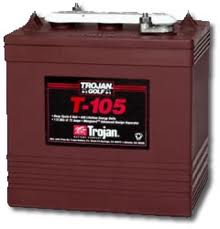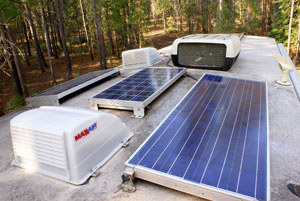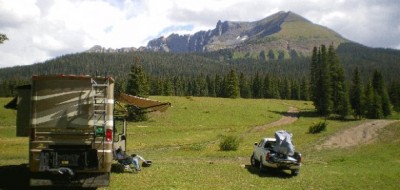By Bob Difley
 Last week in Part IV we looked at ways to conserve electricity by limiting our actual usage. Today, we will flip in the other direction and look at ways to increase the available electricity and add alternative sources of power.
Last week in Part IV we looked at ways to conserve electricity by limiting our actual usage. Today, we will flip in the other direction and look at ways to increase the available electricity and add alternative sources of power.
Lower wattage and Energy Star appliances will take less energy to run, pull fewer amps from your batteries, and run more efficiently–in other words, they’re greener than your older appliances.
However, it is not practical or economical to tear out your old installed appliances and replace with Energy Star (until they need replacement), but you can check before you buy a new RV whether the appliances already installed are in compliance.
You can also vastly improve your electrical system–actually more than doubling your storage capacity–by installing additional or different batteries. Here you have choices. Buy an additional deep cycle flooded lead acid RV battery like the one your rig came with, only don’t add a new battery into a system with older batteries or the older battery will draw energy from the new one. A newer type battery option is the absorbed gas mat (AGM) type, which has no liquid in the cells that must be monitored or refilled. Or you could install two or four 6-volt golf cart batteries. To help you decide as well as learn more than you probably ever wanted to know about batteries go to this text of a presentation by Greg Holder, owner of AMSolar.
 I use four Trojan T-105 6-volt golf cart batteries, about which Greg says, “Best bang for the buck is the Trojan T-105 golf cart batteries — if you have space for them. They are considerably taller, and won’t fit in some compartments. 2 6s in series is better than 2 12V batteries. Longer life, more forgiving, will last twice as long. Cost in range of $65-$85.” NOTE: This was the price when Greg gave his seminar. My most recent price check showed a $115 to $160 range per battery.
I use four Trojan T-105 6-volt golf cart batteries, about which Greg says, “Best bang for the buck is the Trojan T-105 golf cart batteries — if you have space for them. They are considerably taller, and won’t fit in some compartments. 2 6s in series is better than 2 12V batteries. Longer life, more forgiving, will last twice as long. Cost in range of $65-$85.” NOTE: This was the price when Greg gave his seminar. My most recent price check showed a $115 to $160 range per battery.
Just installing more battery capacity will about double your boondocking electrical capability, but by also using alternative, renewable energy sources you can pump amps into those batteries even while you are out in the booniest of boonies. There are four ways to do this: (1) idle your main engine, (2) run your generator, (3) install solar panels,or (4) install a wind turbine.
 The problems with (1) and (2) are that they are noisy, smelly, cause wear and tear on the equipment, require maintenance, use increasingly expensive gasoline, and are inefficient requiring hours of running to plump up a depleted battery.
The problems with (1) and (2) are that they are noisy, smelly, cause wear and tear on the equipment, require maintenance, use increasingly expensive gasoline, and are inefficient requiring hours of running to plump up a depleted battery.
My personal choice, solar, is totally silent, has no moving parts (no wear and tear), requires no maintenance (except a wash off or wipe down occasionally), produces free electricity, and works from dawn’s early light until the sun is over the yardarm without complaint.
The downside with solar is the upfront cost of panels and installation. If you install it yourself you can save some expense. But after that–free energy. If you intend to keep your rig for a while, the cost amortizes out. And it’s so satisfying to look at the control panel and see those amps streaming into your batteries and not have to worry whether you have enough juice left to watch Night of the Living Dead or play Halo 3 after dark.
To figure out what size system you need you have to figure out how much electricity you use on average in a day. You can do this on AMSolar’s system sizing page. Then add a bit for when it is cloudy or rainy or if you estimated a bit low–it’s a good idea to have a margin of error. But, if you are consistently low or your electricity usage grows, you can just add another panel into the system.
 If you typically travel where there is no sunshine (Oregon and Washington in the winter come to mind), prefer to camp under the canopy of a deep forest in summer, or like camping on windy unprotected hilltops than you might want to consider a wind turbine. The newer models are less noisy and have less vibration than older models, and when you hoist them up on a long pole above your rig, it takes just a breeze to get it spinning amps into your system. But if there is no wind, no juice. If you don’t mind spending the bucks and like all this tech stuff, you can install both, like Brian Brawdy did on his camper (see turbine blades in upper right corner of photo).
If you typically travel where there is no sunshine (Oregon and Washington in the winter come to mind), prefer to camp under the canopy of a deep forest in summer, or like camping on windy unprotected hilltops than you might want to consider a wind turbine. The newer models are less noisy and have less vibration than older models, and when you hoist them up on a long pole above your rig, it takes just a breeze to get it spinning amps into your system. But if there is no wind, no juice. If you don’t mind spending the bucks and like all this tech stuff, you can install both, like Brian Brawdy did on his camper (see turbine blades in upper right corner of photo).
Next Saturday I will dive into the water system (pun intended).
Check out my website for more RVing tips and destinations and for my ebooks, BOONDOCKING: Finding the Perfect Campsite on America’s Public Lands, Snowbird Guide to Boondocking in the Southwestern Deserts, and 111 Ways to Get the Biggest Bang out of your RV Lifestyle Dollar.


Pingback: site
Bob Difley
Here is a link to a good battery tutrorial for those who would like more information.
http://www.batterystuff.com/tutorial_battery.html#3
Chip-KJ4EOY
Hi, Bob,
Regarding battery upgrades, our coach uses 4-6 volt batteries and I willprobably need tor eplace them either late this season or early next season. WHen I do, I would like to use Gel Cells. I read where they are sealed and have a much longer life than the standard 6-volt batteries that came with our coach in 2006. What’s the down side to Gel Cells?? Thnx!
Geoffrey Pruett
Solar is very effective and the entry price keeps falling as the market increases, but do not think of Solar as a low fuss add on, this will bite you. The high capacity house batteries require the type of attention that car batteries needed in the day of generators, check the levels regularly, clean any corrosion promptly, and never top up unless a charger is available. If your battery compartment is not easy to access some thought must be put into checking levels and connections. I do this because my background is electrical maint and it is automatic so my systems have been little trouble and we dry camp a lot. Have had several head shaking assistance tries for people out in the camp area with trouble, wrong place to find troubles! Do it your driveway.
Bob Difley
To those who mentioned the price of the Trojan T105 batteries. The price in the post was accurate when Greg gave the seminar. They have since gone up, as you might expect. I have posted the results of my search above, i.e. $115 to $160 each.
richard
T-105 Trojan just bought 6 for my Tradewinds best price and i AM A SHOPPER
120.00 each…….they will out power and out last (with proper maintenance) the outer brands………..Solar installed cut Generator run time by 95%……..We are Boondocking and loving it
Thanks for your articles
Robert Madden
Yes I found the same thing the t105’s are around the $150 mark. Please advise where you found them new for $65 – $85.
I do follow your Blogs and appreciate the info.
Salvatore Lauriola
I had considered going to golf cart batteries in my Travel Trailer but for now I went with a second 12v deep cycle as the one I had already was new. BTW according to a web search those batteries are more like $150.00-160.00 apiece, not $80.00. I got prices from 3 places
William Fincher
Coyote camping for years, 5.5 gen set, I use for micowave,etc. I put in 3 jel pac batteries in the coach in series. The batteries are rated for a diesel truck, a little more reserve capacity.I purchaced a small solar charger, a cheap one at that, and we run the sattalite tvs, etc and have no problems to this point.If i get in trouble, we have two full batteries in the truck.Life is good in the boonies!
Herb Lapp
My 2 cents says the RV market is too competitive or cost conscious while the number of people who actually do this Robinson Caruso camping off the grid is too small to cost justify the offering. It seems to be a small niche market that will have to be served by entrepreneurs and the Do It Yourselfer.
Jim G
Hi Bob,
I continue to enjoy reading this well written series, which got me wondering, (a dangerous personal habit of mine).
Am I missing something but it would appear that new RV manufacturers and consumers would benefit by installing multiple 6 volt systems, as you have versus the all too common 1 or 2 batteries of the 12 volt style. I have read many RV articles which collectively support your opinion so arent the manufacturers listening or is it too expensive to modify an electrical system during assembly, or something else?
Wallace Cook
Bob, can you recommend a wind generator company? or Two? I do agree with you on using solar panels. At home, I have 24 panels producing 4.3 KW of power, and on my RV I have 2 panels 290 watts of power. I have not had to run my generator except to keep it lubercated every few months.